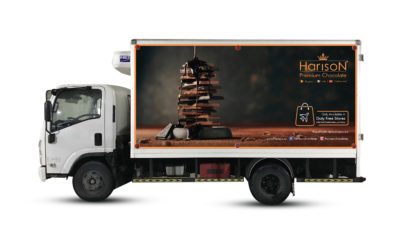Premium chocolate brand Harison, which is exclusive to travel retail, has launched a social media and advertising campaign outside of the travel retail environment to increase footfall in the channel.
As reported, Harison, which launched five years ago, has achieved 40% year-on-year growth in each of its three years of trading. It aims to become a top 10 brand within the travel retail confectionery category in the next five years.

Its campaign runs across multiple locations and includes Facebook, Instagram, Google, YouTube, radio, out-of-home signage and influencers. It aims to increase engagement and awareness among potential travellers and shoppers, Harison said.
“The power of media outreach like this cannot and should not be underestimated,” the brand added.
Harison said its digital campaign put the brand in contact with over 3.5 million people, while radio spots offered a potential further audience of almost 1.5 million every week.
Its collaboration with 10 influencers brought the brand to a further 800,000 users across Facebook and Instagram. Every post scored thousands of likes and developed Harison’s online presence, the company added.
“A media campaign like this is regularly putting the brand and the travel retail market in front of millions of people and that is not a market the sector can afford to overlook.”
Since its launch in July, Harison’s digital outreach across Facebook, Instagram, YouTube and Google has been seen more than 5 million times. The brand noted over 370,000 users clicked on its advertisement. “With a click-through rate of more than 7%, this means Harison’s campaign far outstrips the average click-through rate of about 2%.”
Harison puts the campaign’s success down to “uniqueness and sensible strategic deployment”.
“Importantly,” the brand added, “both of these are advantages the wider travel retail industry could – and should – be making the most of.”
“Exclusivity is a key tenant of travel retail and a media campaign allows the industry to highlight the differentiation which will draw in new shoppers. If social media adverts display a product which browsers have not seen before then they are more likely to click and engage; once they do that, they are more likely to shop.”

Harison emphasised the role of interactivity. “Google ads will receive a much higher impression rate – Harison’s campaign recorded more than 700,000 impressions from Google in Singapore in July alone – but the interactive nature of social media leads to much higher engagement rates.”
Harison said platforms like YouTube offer brands the opportunity to have a voice and personality. Click-through rates from YouTube advertising were above 40% and upwards of 90% in Singapore for both July and August, the company added.
It also identified targeting a campaign to the right areas as another key to success. “As with any paid campaign, the company has wanted to maximise its investment. By rolling out its promotion in markets such as Abu Dhabi, where it holds top position in the confectionery category with DFS, and potent developing markets such as Delhi and London – which have both strong confectionery markets and large annual passenger numbers – it is maximising the opportunity to engage with new shoppers.”

Harison ran a multi-lingual radio campaign across two UAE stations, with an average of ten spots every day. This resulted in 140 opportunities every week to reach almost 1.5 million listeners, the company said.
Harison has also added vehicle branding to its campaign, with ten pick-ups carrying the Harison name and visuals.
“As the travel retail industry faces more and more changes and challenges, we as stakeholders must be bold and innovative in our use of the opportunities to interact with customers and ensure that growing passenger numbers mean a ripe future for our unique market,” Harison concluded.

